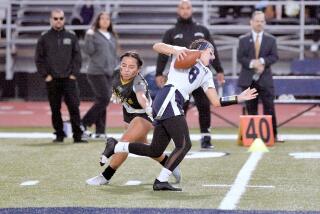The horsy hideaway of Hidden Hills has...
The horsy hideaway of Hidden Hills has more bridle trails than streets. It also has a surveillance system most banks would envy, tracking the comings and goings of those living in and visiting the affluent, walled township.
Residents pride themselves on keeping the pastoral splendor of their hills hidden. The small, elite, gated community, north of the Ventura Freeway and west of Woodland Hills, has million-dollar-and-up homes--and no apartments, condominiums, street lights, sidewalks, restaurants, markets or, well, poor people.
There’s just one pay phone, located outside City Hall--a place that bears a plaque reading: “On this site in 1897, nothing happened.”
Despite its exclusive reputation, Hidden Hills was anything but glamorous back in the 1950s when it became one of the first fortressed cities in the state. The tenuous local water supply had a tendency to run dry in the summer and clog up coffee pots the rest of the time. Instead of Arabians and Thoroughbreds, residents rode back-yard horses and kept chickens, geese, sheep and donkeys. In fact, the original developer gave away burros with each lot.
The city derives its powers from the covenants, codes and restrictions written when landscape architect and developer A.E. Hanson--the “Southern California green thumb” to such luminaries as Mary Pickford and Douglas Fairbanks, Edward Doheny, Harold Lloyd and auto magnate E.L. Cord--founded the community in the 1950s.
The ads for the postwar development of “1,000 Acres of Elbow Room” stressed “the peace and contentment of the country,” where you could “own your own rancho at less than the price of a city lot.” One-acre lots sold for $18,650.
In 1961, when Los Angeles started talking about punching Burbank Boulevard through the center of Hidden Hills, the residents formed their own city and locked the gate behind them.
(BEGIN TEXT OF INFOBOX / INFOGRAPHIC)
Hidden Hills Inside Out
SYSTEM GLITCH: In 1978, the U.S. Treasury Department mistakenly listed Hidden Hills as one of the nation’s most distressed cities. A computer popped out the town’s name because it qualified in three of four areas: a population growth of less than 4.1%, employment growth of less than 16.4% and a per capita income growth of less than 44.4% over several years. The area in which the city failed to qualify: having a per capita income of less than $1,498. In fact, today the median household income is $166,489 per year.
DON’T SPEND IT ALL IN ONE PLACE: A year after the passage of the tax-slashing Proposition 13 in 1978, the city was hit especially hard because of its complete lack of businesses. Its share of the state’s sales tax, based on the city’s retail sales: 59 cents for the year.
CELEBRITY POWER: Hidden Hills has harbored stars including Beau Bridges, Frankie Avalon, Neil Diamond, Tony Orlando, Sinbad, Howie Mandel and John Davidson. In 1980, Davidson was charged with putting up lights on his tennis court without a permit. He argued that the ordinance violated the equal protection clause of the U.S. Constitution because it prohibits lights on tennis courts while allowing lights on corrals and basketball courts. He found a way to keep the lights, saying they were for a trampoline.
WHICH VALLEY? In 1993, New York-based Vanity Fair magazine made some bizarre comparisons, calling Pasadena “the Brentwood of the Valley,” Calabasas “the Malibu of the Valley,” and Hidden Hills “the Bel-Air of the Valley.”
UPROAR: Gus, a defanged, de-clawed, 300-pound lion--kept as a family pet--was ordered out of Hidden Hills in 1978 after the City Council, which had enacted a law banning wild animals, received a complaint. Residents came to the feline’s defense, but a proposed citywide law that would have allowed him to stay in a back-yard cage failed by 16 votes. Rather than do away with Gus, the family left town for Utah.
FLEXING MUSCLE: In 1990, residents threw out three of the five council members for proposing a low-income, senior citizen housing project that was required if the city was to receive $100 million in redevelopment funds for a flood repair project. Residents then disbanded the redevelopment agency, canceled a deal with the developer and fired the city attorney. When the developer sued, Hidden Hills settled out of court for $1 million.
(BEGIN TEXT OF INFOBOX / INFOGRAPHIC)
By The Numbers
City Business
Date founded: Oct. 19, 1961
Area: 1.8 square miles
Parks: 0
City employees: 3
1995-96 budget: $1 million
*
People
Population: 1,729
Households: 502
Average household size: 3.44
Median age: 39.6
*
Ethnic Breakdown
Asian: 3%
Latino: 7%
White: 89%
*
Money and Work Median household income: $166,489
Median household income / L.A. County: $34,965
Median home value: $746,200
Employed workers (16 and older): 796
Women in labor force: 45.5%
Self-employed: 117
Car- poolers: 75
*
Number of Cars Per Household
One: 6%
Two: 29%
Three or more: 65%
*
Ages
17 and younger: 28%
18-34: 16%
35-49: 29%
50-64: 19%
65 and older: 8%
Source: Claritas Inc. Household expenses are averages for 1994. All other figures are for 1990. Percentages have been rounded to the nearest whole number.
More to Read
Sign up for The Wild
We’ll help you find the best places to hike, bike and run, as well as the perfect silent spots for meditation and yoga.
You may occasionally receive promotional content from the Los Angeles Times.





